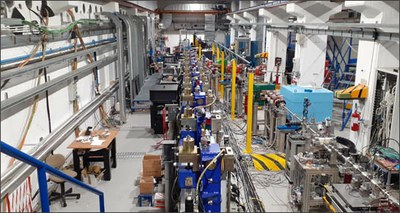Innovation: ENEA takes the field for 500 million euro super accelerator
11/11/2021
 Developing in Italy a super accelerator of subatomic plasma particles, capable of obtaining higher energies than current accelerators with smaller size and reduced costs, for industrial, pharmaceutical and biomedical applications. This is the goal of the project EuPRAXIA (EUropean Plasma Research Accelerator with eXcellence In Applications), funded with approximately 500 million by the European Strategic Forum for ESFRI Research Infrastructures [1] of which 108 by the Ministry of University and Research. In addition to ENEA, INFN (leader), Cnr, the universities of Rome Sapienza and Tor Vergata and Elettra Sincrotrone Trieste also participate.
Developing in Italy a super accelerator of subatomic plasma particles, capable of obtaining higher energies than current accelerators with smaller size and reduced costs, for industrial, pharmaceutical and biomedical applications. This is the goal of the project EuPRAXIA (EUropean Plasma Research Accelerator with eXcellence In Applications), funded with approximately 500 million by the European Strategic Forum for ESFRI Research Infrastructures [1] of which 108 by the Ministry of University and Research. In addition to ENEA, INFN (leader), Cnr, the universities of Rome Sapienza and Tor Vergata and Elettra Sincrotrone Trieste also participate.
What makes the project innovative is the creation of the first model in the world capable of generating an acceleration even 100 times higher than conventional accelerators and working at high energy and with much more compact machines, that can be installed and managed in campus universities or hospitals. Approximately 50-60 meter long, the Italian plasma accelerator will in fact be almost three times more compact than a conventional one.
"This project meets the growing need for small accelerators, for a more widespread, capillary use and a simpler management, with higher performance, the possibility of new application areas [2] and lower construction, maintenance and personnel costs compared to the approximately 30 thousand models in operation ”, explained Federico Nguyen, researcher at the ENEA Laboratory of Theory, Simulation and Modeling. The project envisages the construction of two hubs, one at the INFN, opposite the ENEA Frascati Research Center, the second site is yet to be defined, operative in 2028.
Particle accelerators were born as a driving force for the progress of science: in addition to providing a sophisticated instrument for the investigation of matter and the universe, they are used in various sectors of basic research and widely spread in application fields like industry and biomedicine.
Since its establishment in the 1960s, ENEA has been leader in the design and construction of radiation sources throughout the electromagnetic spectrum and in the development of FEL (Free Electron Laser) or Free Electron Laser sources, the main application of EuPRAXIA, the study of biological substances, new materials for industrial research and the conservation of cultural heritage. The Agency also has a leading role in drafting the Conceptual Design Report, coordinating the activities to obtain outcomes on the new generation FEL source which will enable us, for instance, to reconstruct DNA crystallographic images and explore the structures of bacteria and viruses, with new applications in the pharmaceutical and biomedical fields.
"In this historical and logistic context, the Frascati research hub - of which the ENEA Research Center is a part - becomes a crucial scientific and technological structure of excellence, capable of attracting the best international researchers and combine the most innovative acceleration schemes of subatomic particles with the most advanced laser technologies, with a significant impact in technology transfer to companies and benefits that go beyond the world of research ", pointed out Marco Ciotti, head of the ENEA Fusion Physics Division.
For more information please contact:
Federico Nguyen, ENEA - Theory, Simulation and Modelling Laboratory - Fusion Physics Division - Email: federico.nguyen@enea.it
[1] Established on AN initiative of the Council of the European Union to address the main challenges of growth in Europe, ESFRI supports European strategic research infrastructures, promotes their scientific integration and enhancement also at an international level.
[2] EuPRAXIA Conceptual Design Report, published on European Physical Journal Special Topics229 (2020) 3675.
